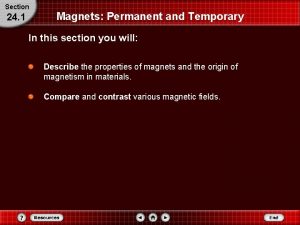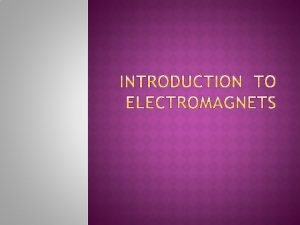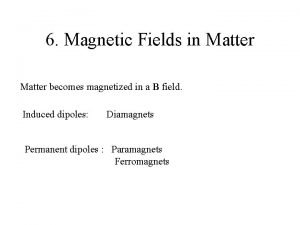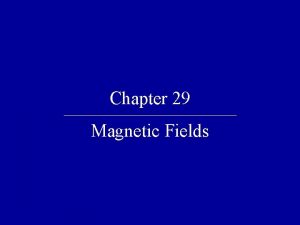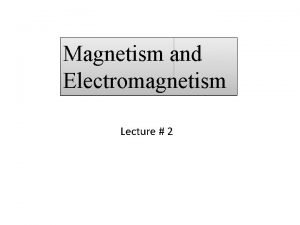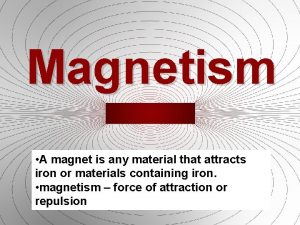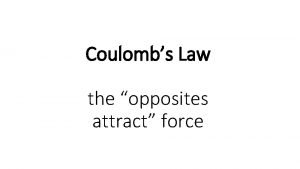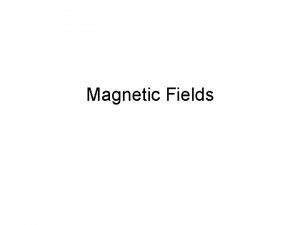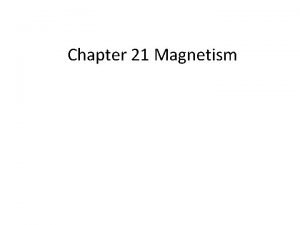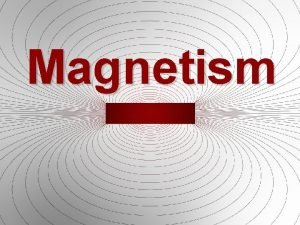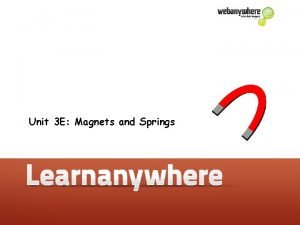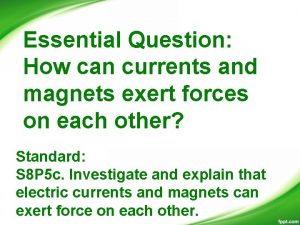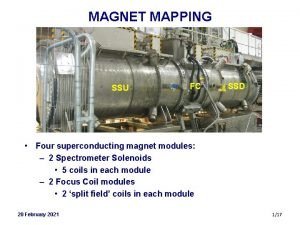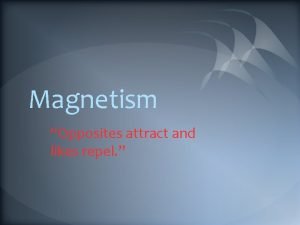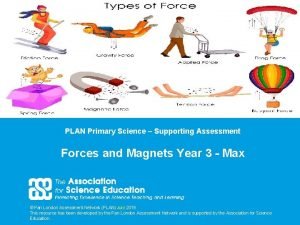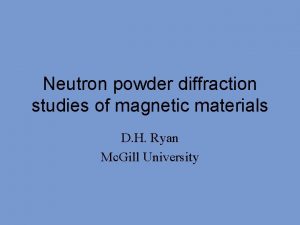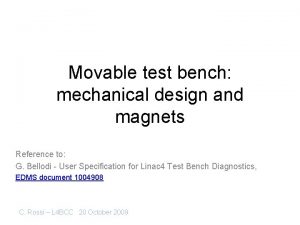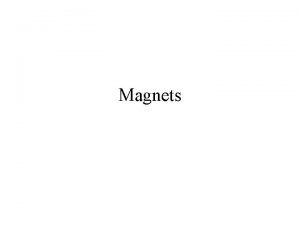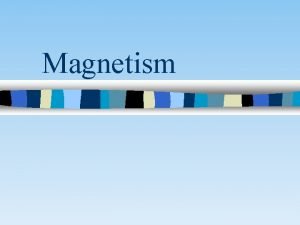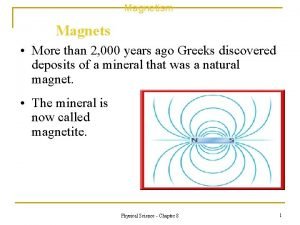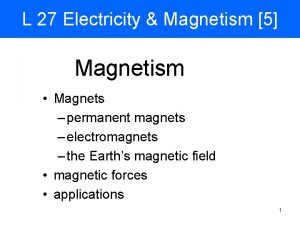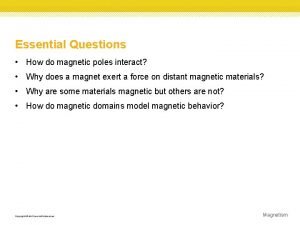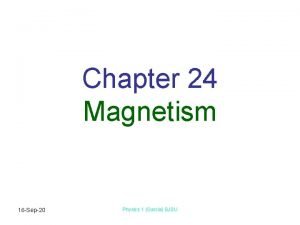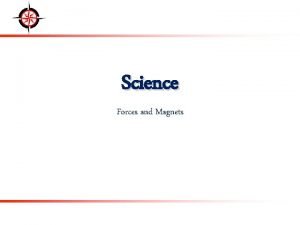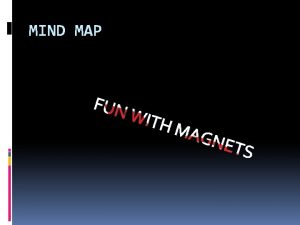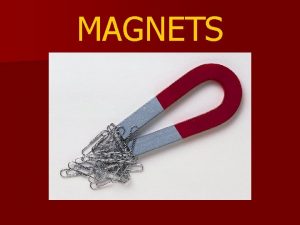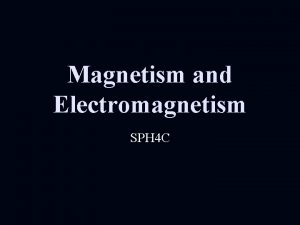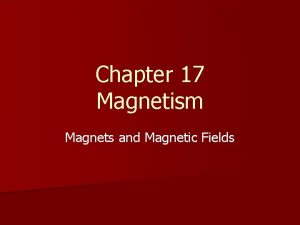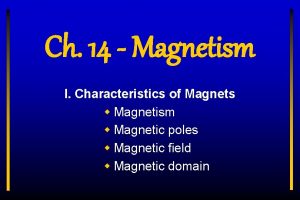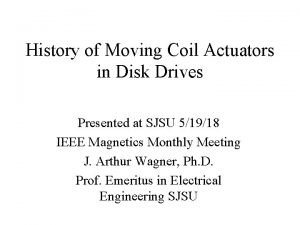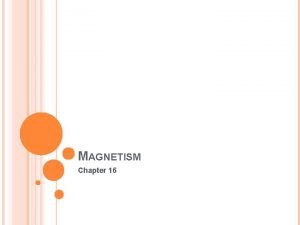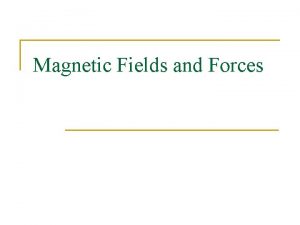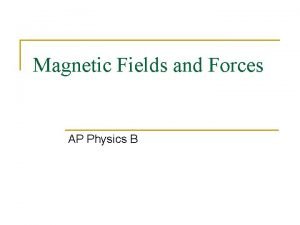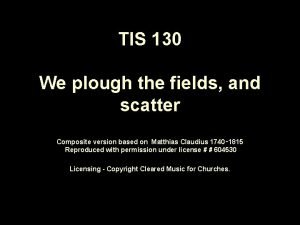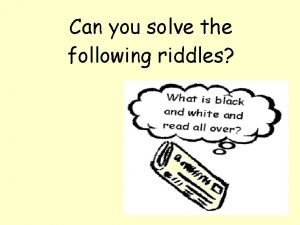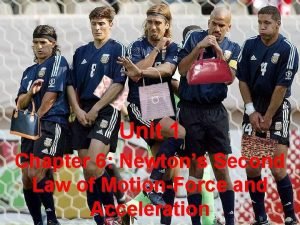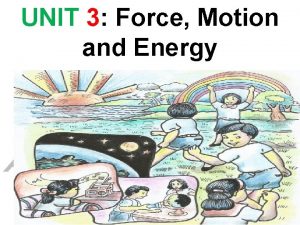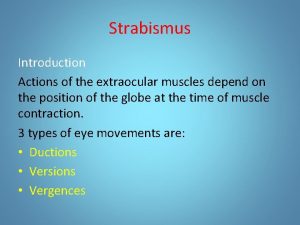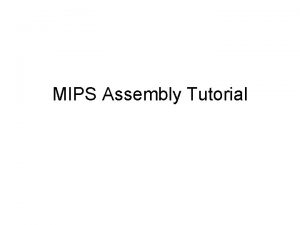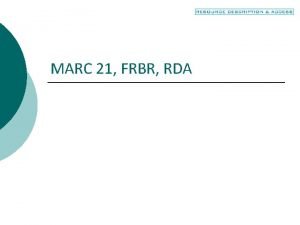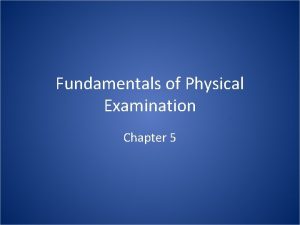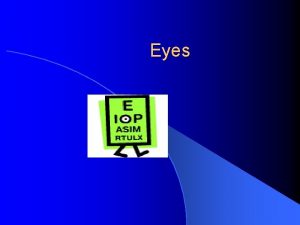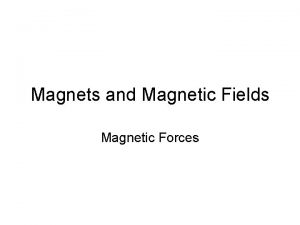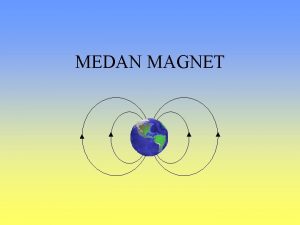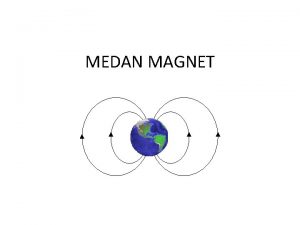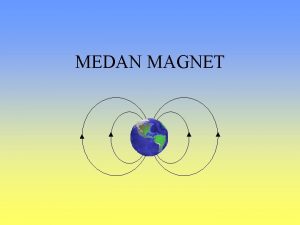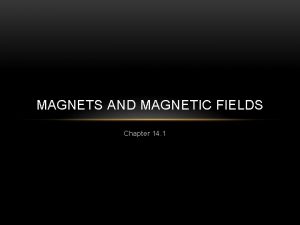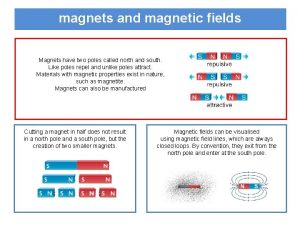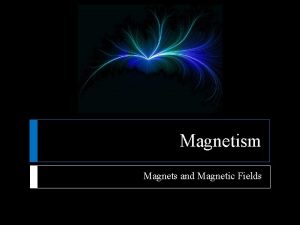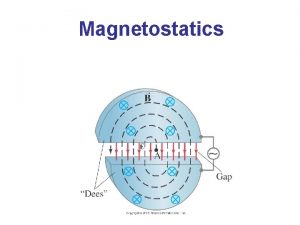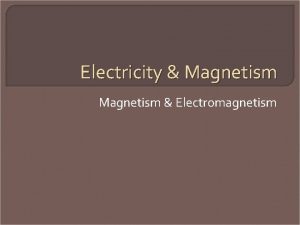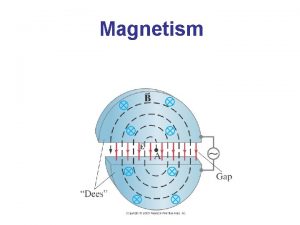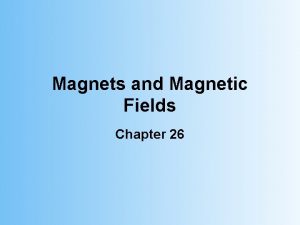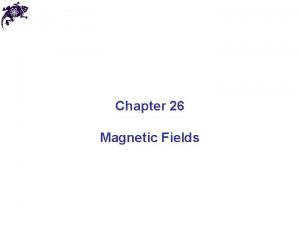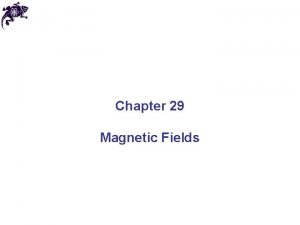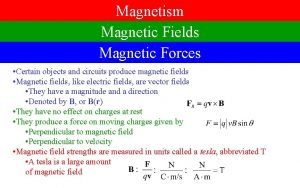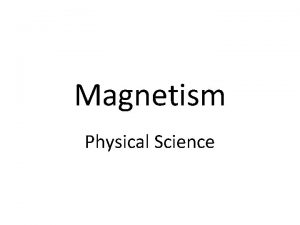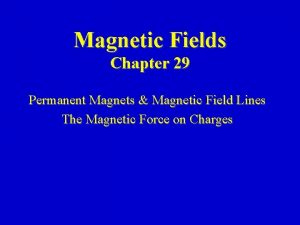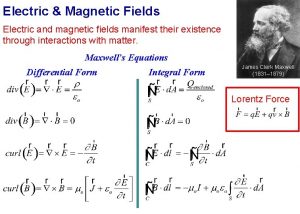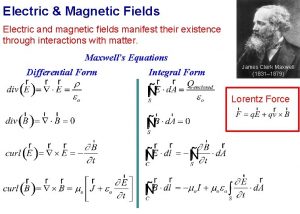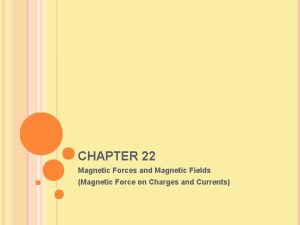Magnets and Magnetic Fields A Magnet attracts certain



















































































- Slides: 83

Magnets and Magnetic Fields

A Magnet attracts certain materials to itself. A magnet will attract Iron, Steel, Nickel, Cobalt and some alloys of these. A magnet has no noticeable effect on other materials. A Bar Magnet is strongest at each end. Dip a bar magnet into iron filings or a box of pins. It attracts the filings or the pins to itself. Most cling on at each end of the magnet. The regions of greatest strength at each end are called Magnetic Poles.

If a Bar Magnet is suspended freely it will line up approximately North-South. The pole of the magnet that always points North is called the North-Seeking Pole or the North Pole. The pole that points south is called the South-Seeking Pole or the South Pole.

Magnetic Poles occur in Pairs. You cannot have a single pole on its own. For every north pole there is always a south pole. The strength of the north pole is the same as the strength of the south pole. Like poles repel and unlike poles attract The North Pole of one magnet repels the North Pole of another. The South Pole of one magnet repels the South Pole of another. The North Pole of one magnet is attracted to the South Pole of another magnet.

A Magnet causes some materials brought near it or touching it to become magnetised. This magnetism is called Induced Magnetism. If the magnet is taken away some materials (called permanent magnets) hold on to their magnetism but others (called temporary magnets) lose most of it. Hard steel holds onto magnetism very well whereas soft iron does not. Ordinary nails are usually made from soft iron and do not retain their magnetism very well.

What is a Magnetic Field? A Magnetic Field is any region of space where magnetic forces can be felt. What is the Direction of a Magnetic Field ? The Direction of the Magnetic Field at a point is the direction of the force on a north pole if it was placed at that point.

What is a Magnetic Field Line? A line drawn in a magnetic field so that the tangent to it at any point shows the direction of the magnetic field at that point is called a Magnetic Field Line. What are Magnetic Poles? Magnetic poles are the regions at each end of a magnet where the magnetic forces are greatest. Magnetic poles are always found in pairs.

A Plotting Compass is a small magnet that can rotate about a vertical axis. If no other magnets are nearby it will line up North-South. If another magnetic field is present it will deflect the compass needle from its N-S position. If the other field is strong enough the compass needle will line up almost parallel to the field rather than North-South.

The Magnetic Field around a Bar Magnet The magnetic field lines start at the north pole and end at the south pole. The magnetic field lines never cross each other. Near the poles - where the magnetic field is strongest the lines are close together. Further away, where the field is weaker, the lines are far apart.

Iron Filings showing the Magnetic Field around a Bar Magnet

The magnetic field around a U-shaped Magnet Earth’s Magnetic Field, pointing approximately North

What is the Magnetic Effect of an Electric Current? Every Current-Carrying Conductor has a Magnetic Field around it caused by the current. As long as the current is flowing the Magnetic Field exists. If the current stops flowing the Magnetic Field disappears.

Experiment to show the Magnetic Effect of an Electric Current Set up the equipment with the wire lined up North-South. The plotting compass also lines up N-S. Close the switch, sending current through the wire. The compass needle will deflect. Reverse the direction of the current and the needle deflects in the opposite direction. Open the switch, no current flows, the magnetic field disappears and the compass again lines up N-S. Conclusion: Every current carrying conductor has a magnetic field around it caused by the current.

The Magnetic Field around a Long Straight Wire

The Right-Hand Grip Rule If a Right Hand clasps a conductor with the Thumb pointing in the direction of the Current Then the Fingers give the direction of the Magnetic Field around the conductor. The thumb points in the direction of conventional current, i. e. from + to -

A Circular Loop of Wire carries a current in the direction shown. Using the Right-Hand Grip Rule at a number of points on the wire shows us the shape of the magnetic field around the loop. The side of the loop facing us behaves like a South Pole (the magnetic field lines are going in) The other side is like a North Pole (the magnetic field lines are coming out).

The Magnetic Field around a Current-Carrying Coil (or a loop)

The Magnetic Field around a Current-Carrying Solenoid

What is an Electromagnet? A Solenoid carrying a current and containing a soft iron core is known as an Electromagnets are used in: Scrap yard cranes Electric motors Electric bells Moving coil loudspeakers Induction coils By turning the current on or off the magnet can be turned on or off. By varying the size of the current the strength of the magnet can be varied.

A powerful Electromagnet lifting scrap Iron

A Magnetic Compass shows the direction of the Earth’s Magnetic Field and it is used in navigation. The Earth’s Magnetic Field forms a protective layer (from charged particles) around the Earth.

The Magnetic Compass has been used for hundreds of years in marine navigation, since it enables you to know direction. The angle between True North and Magnetic North is also of importance. Charts and maps used in navigation have its value in the locality of the chart noted on them since navigators must allow for it in their calculations.

To show that a Current-Carrying Conductor in a Magnetic Field experiences a Force Send a current through the tinfoil. The foil will move forwards. Reverse the current and the foil will move backwards. Conclusion: A current-carrying conductor in a magnetic field experiences a force.

The moving coil meter and the moving coil loudspeaker are based on the principle that a current-carrying conductor in a magnetic field experiences a force.

A simple d. c. Motor is based on the principle that a currentcarrying conductor in a magnetic field experiences a force.

Why would you expect a current-carrying conductor placed in a magnetic field to experience a force? A current-carrying conductor has a magnetic field around it due to the current. When this conductor is placed in another magnetic field, the two magnetic fields interact (push off each other!). This causes the force on the current-carrying conductor.

What is the Direction of the Force on a Current-Carrying Conductor in a Magnetic Field? The direction of the force is always: Perpendicular to the current Perpendicular to the magnetic field NOTE: A Current-Carrying Conductor in a magnetic field experiences no force if the conductor is parallel to the magnetic field.

Fleming’s Left-Hand Rule: If the thumb, first finger and second finger of the left hand are held at right angles, with the first finger in the direction of the magnetic field and the second finger in the direction of the current, then the thumb points in the direction of the force.

What determines the Size of the Force on a current-carrying conductor in a magnetic field? The size of the Current The Length of the conductor How strong the Magnetic Field is The Angle between the conductor and the magnetic field

Magnetic Flux Density (B) Is the magnitude of the magnetic field strength(B): F I It follows that: F l and F Il F = Il. B where B is a constant. The value of B depends on how strong the magnetic field is. In a strong magnetic field B is large and in a weak field B is small. Thus B is a measure of how strong the magnetic field is. B is called the Magnetic Flux Density.

Define Magnetic Flux Density At a point in a magnetic field the Magnetic Flux Density ( B ) is a vector whose: • direction is the direction of the force on a north pole placed at that point • magnitude is the value of B from the equation F = I l B The SI unit of magnetic flux density is the tesla (T) or put another way: The magnetic Flux Density (B) at a point in a magnetic field is a vector whose: magnitude is equal to the force that would be experienced by a conductor of length 1 m carrying a current of 1 A at right angles to the field at that point. Its direction is the direction of the force on a north pole placed at that point.

If the conductor is not perpendicular to the field resolve the B into two perpendicular components - one parallel to the conductor and the other at right angles to the conductor. It is the component of B that is perpendicular to the conductor that causes the force on it. The parallel component has no effect on the wire. F = B I l Sin 0 o

The coil is free to rotate about the axis. Convince yourself that the directions of the forces on the sides of the coil are correct and that the coil will begin to rotate.

To Show the Force on a current-carrying coil in a magnetic field Use the equipment above. The coil is free to rotate about the axis. When the current is switched on the coil starts to rotate as shown.

A Beam of Electrons in a cathode ray tube is an Electric Current A beam of electrons in a cathode ray tube moves in a vacuum. The beam passes close to a fluorescent screen and shows up as a beam of light. The moving electrons have negative charge and thus are an electric current. They, therefore, have a magnetic field around them.

Force on a Moving Charge in a Magnetic Field This magnetic field, due to the beam of moving charges (the electrons), will interact with any other magnetic field placed near it. The picture shows the beam of electrons deflecting due to the presence of a bar magnet.

The Size of the Force on a Moving Charge in a Magnetic Field A charge of q coulombs moving with a speed of v metres per second at right angles to a magnetic field of flux density B teslas experiences a force of F newtons, given by; F = qv. B

A charged particle moving at constant speed enters a uniform magnetic field and moves at right angles to the field. Explain why the particle moves in a circle? . When the charged particle enters the magnetic field there is a force on it. The force is at right angles to its direction of motion. Therefore its speed does not change. Only its direction of motion changes. The force on it has a constant magnitude (F = q v B. ). As it turns the force always remains at right angles to the direction of motion. Thus the particle moves in a circular path.

Electric Current and Electric Charge What is an Electric Current? An Electric Current is a flow of charge. What is the SI Unit of electric current? The ampere (A). What is the SI Unit of electric charge? The coulomb (C). Define the coulomb. 1 coulomb is the amount of charge that passes any point in a circuit when a current of 1 ampere flows for 1 second.

Electric Current and Electric Charge What is the relationship between Electric Current and Electric Charge? The current (I) is the amount of charge (Q) passing per second Q = It Where: Q is charge gone past I is the steady current t is the time taken.

Magnetic Forces between Currents Two parallel conductors carry current in opposite directions. Each current creates a magnetic field around itself. The magnetic fields interact with each other and cause a force on each conductor, pushing the conductors apart. If the conductors carry current in the same direction the force between them is attractive.

State the principle on which the definition of the ampere is based. The definition of the ampere is based on the principle that: Two current carrying conductors exert a force on each other due to their magnetic fields.

The Ampere The ampere is that current which: • if maintained in two infinitely long parallel wires, is of negligible cross section • is placed 1 metre apart in a vacuum • would produce a force on each wire of 2 × 10 -7 newtons per metre of length

What is Magnetic Flux? Magnetic flux is defined as: = BA Where: = magnetic flux B A = magnetic flux density = area Magnetic flux through Area A is equal to Magnetic Flux Density × Area

What is the SI Unit of Magnetic Flux? The SI Unit of Magnetic Flux is the weber (Wb). Magnetic flux is a Scalar Quantity.

What is the magnetic flux through a loop of area 0. 5 m 2 placed at right angles to a magnetic field of flux density 3 T? = B = 3 T BA = (3)(0. 5) = 1. 5 Wb A = 0. 5 m 2

What if the magnetic field is not perpendicular to the area? Resolve the magnetic flux density B into components parallel and perpendicular to the area. Flux through A = Component of B perp to A × (area A) In the diagram : Component of B perp. to coil = B Sin 30 o = 2 Sin 30 o = 1 T Flux through coil = B × A = (1)(0. 4) = 0. 4 Wb

What is Electromagnetic Induction? Whenever the magnetic field passing through a coil changes an emf appears in the coil. This is Electromagnetic Induction.

To Demonstrate Electromagnetic Induction Move the magnet towards (or away from) the coil. The galvanometer deflects, indicating that current flows and that an emf appears. When the magnet is not moving the meter reads zero.

State Faraday’s Law of Electromagnetic Induction. Faraday’s Law states that the induced emf is directly proportional to the rate of change of magnetic flux.

Experiment to demonstrate Faraday’s Law of Electromagnetic Induction Move the magnet towards the coil slowly. The galvanometer gives a small deflection, indicating a small induced emf. Move the magnet towards the coil quickly. The galvanometer gives a large deflection, indicating a large induced emf. Conclusion: The induced emf is directly proportional to the rate of change of magnetic flux through the coil.

As the man runs towards a coil the magnetic flux through the coil increases. An emf is induced in the coil. By Lenz's Law the current induced in the coil flows in a direction that opposes the north pole of the magnet approaching. The current flows in a direction that causes the end of the coil facing the approaching magnet to behave like a north pole (north repels north). Because of this opposition the man must do work to bring the magnet nearer the coil. The work he does appears as electrical energy in the coil.

As the man runs away from the coil the direction of the induced current changes so that his motion is still opposed. The direction of the induced current changes so that a south pole appears at the right hand side of the coil (south attracts north). The work the man does in pulling a north pole away from a south pole again appears as electrical energy in the coil.

State Lenz’s Law states that the induced current flows in such a direction as to oppose the change causing it. Lens’s law follows from the Principle of Conservation of Energy.

Experiment to demonstrate Lenz’s Law Drop a metal cylinder through a copper pipe. Note how long it takes to fall through the pipe. Drop a strong cylindrical magnet (same size and weight as the metal cylinder) through the copper pipe. It takes much longer to fall through. As the magnet falls through the pipe, its changing magnetic field induces currents in the pipe. By Lenz’s Law these currents flow in such a direction as to oppose the change producing them, i. e the moving magnet. They exert forces on the magnet slowing it down. The non magnetic metal cylinder does not experience these forces Thus Lenz’s Law is demonstrated.

Experiment to demonstrate Lenz’s Law Hang a light aluminium ring from a piece of thread. Move the north pole of a bar magnet quickly towards the ring. The ring moves away from the magnet. Move the north pole quickly away from the ring and the ring follows the magnet. Conclusion: As the north pole approaches current is induced in the ring. A north pole appears at the side of the ring nearest the magnet. The magnet repels it and the ring moves away. When the north pole is taken away the direction of the induced current changes, a south pole appears at the side of the ring facing the magnet. The ring is attracted to the magnet and follows it. This agrees with Lenz’s Law and thus the law is demonstrated.

What is an Electric Generator? An Electric Generator is a device that converts mechanical energy into electrical energy. The alternator in a car is an electrical generator. This one has a maximum power output of 1 k. W.

Electric Generators Electromagnetic Induction is the principle on which the Electric Generator is based. In an electricity generating station some form of energy e. g. chemical energy from coal or oil is used to produce steam which causes a turbine to rotate - i. e. the turbine is given kinetic energy. The turbine rotates a coil in a magnetic field thereby causing the magnetic flux through it to change and an emf is induced in it. Thus the kinetic energy is converted to electrical energy.

Everyday examples of Electric Generators Electricity Power Stations which generate huge quantities of electricity. The Alternator in a Car is turned by the engine and generates electricity to supply power to the car’s electrical system to continually keep the car battery charged. The Dynamo on a bicycle generates electricity to operate the bicycle’s lights.

What is alternating Current (a. c. )? An electric current that periodically reverses the direction in which it flows is called Alternating Current (a. c. ). The current that flows through an ordinary domestic light bulb when connected to the mains electricity supply reverses direction 100 times every second. Mains Electricity is alternating current.

Alternating Current A Graph of Current against Time for alternating current

Alternating Voltage To produce alternating current an alternating voltage is needed. The diagram shows a graph of an a. c. voltage against time on an oscilloscope. If alternating voltage is applied across a pure resistor the current flowing at any instant is found from Ohm's Law.

Alternating Voltage / V Graph of Voltage against Time for A. C.

A. C. and Heating 3 A d. c. flows in a 6 resistor. Heat is produced in the resistor at a rate given by Joule's Law: P = I 2 R = (3)2(6) = 54 J s-1 If Alternating Current flows in the resistor what is the maximum value of the a. c. if it produces heat at the same rate as the 3 A d. c. ? Clearly if the a. c. only reaches 3 A in each direction it will not produce heat at the rate of 54 J s-1, because the current is less than 3 A at all other times in each cycle.

rms Value of an Alternating Current (or Voltage) When we state that the value of an Alternating Current is 5 A, we mean that this alternating current has the same heating effect as a 5 A direct current. Since alternating current varies with time, to have the same heating effect as a 5 A d. c. it must have a maximum value in each direction which is greater than 5 A. The stated value of an alternating current is called its rms value ( symbol Irms ). The Maximum or Peak Value of the current is symbolised: I 0

It can be shown that: and The same thing applies to alternating voltages: and

Peak voltage (V 0) and rms Voltage (Vrms) The peak voltage of the mains electricity in Europe is 325 V. Calculate the rms voltage of the mains. Mains voltage is supplied at an rms value of 110 V in the US. Calculate the peak value of the voltage.

What is Mutual Induction? If a changing electric current in one coil causes an induced emf to appear in a nearby coil there is said to be Mutual Inductance between the two circuits.

How can the amount of Mutual Induction between two coils be increased? Move the coils nearer each other. Wind the coils on the same soft Iron core. Increase the number of turns on either or both of the coils. Mutual inductance occurs in the Transformer and the Induction Coil.

Experiment to show Mutual Induction When the switch S is opened (or closed) the current in coil 1 changes and thus the magnetic field around it changes. This changing magnetic field passes through coil 2. As this happens the galvanometer in coil 2 gives a deflection showing that an emf is induced in coil 2. There is thus mutual inductance between the two coils.

What is Self Induction? Whenever the current passing through a coil changes the magnetic field surrounding that coil changes. This changing magnetic field induces an emf in the coil that opposes the changing current. (This emf is called a back emf ). This phenomenon is called Self Induction.

Experiment to demonstrate Self Induction When the switch is closed the bulb does not light immediately. It takes a number of seconds for the bulb to reach full brightness. This is due to the self inductance of the coil.

Explanation of the Experiment to demonstrate Self Induction When the switch is closed the current starts to flow and immediately produces a magnetic field around the coil. This field is increasing. Since the coil now has a changing magnetic field in it, by Faraday's Law an emf will be induced in the coil. By Lenz's Law the direction of the emf opposes the change producing it, i. e. it opposes the increasing current. The induced emf opposes but does not succeed in preventing the current from increasing. Such an emf is called a Back emf.

The Effect of an Inductor on a. c. A 12 V battery sends a 2 A d. c current through a 6 Ω resistor. If a 12 volt a. c. source (Vrms = 12 V) is connected to a coil of resistance 6 with a soft Iron core in it, current still flows. However the current that now flows, is much less than 2 A. The reason is: Alternating current continually changes and so the magnetic field around the coil also changes. By Faraday's and Lenz's Laws an emf is induced in the coil that always opposes the changing current. It is this back emf that causes the coil to offer more opposition to a. c. than to d. c.

A filament lamp lights when connected in series with an a. c. power supply and a coil. Explain why the lamp goes out when a soft Iron core is inserted into the coil. The core causes an increased magnetic flux in the coil and hence a greater rate of change of magnetic flux. A coil carrying a. c. has a back emf. The greater rate of change of magnetic flux causes the back emf to increase. This reduces the net voltage and the current decreases. The lamp goes out because the current decreases.

A. C. and Inductors A coil (an inductor) opposes the flow of direct current (d. c. ) with its Ohmic Resistance. A coil (an inductor) opposes the flow of alternating current (a. c. ) with its Ohmic Resistance and the Back emf Induced in it.

A Dimmer Switch

What is a Transformer? A Transformer is a device used to change the value of an Alternating Voltage.

Structure of a Transformer A Transformer consists of two coils of wire wound on a soft Iron core. One coil, called the Primary Coil has an alternating voltage, called the Input Voltage, applied to it. The transformer causes a different voltage to appear across other coil, called the Secondary Coil. The voltage across the secondary coil is the Output Voltage.

How a Transformer Operates The Input Voltage Vi across the primary coil causes alternating current in the primary coil. This current causes an alternating magnetic flux in the Iron core. This alternating flux passes through the secondary coil and induces an emf Vo in it. Vo is the Output Voltage. The size of the Output Voltage, Vo, depends on the number of turns in the secondary Ns and Np, the number of turns on the primary coil.

Transformer Formula Vi = Input Voltage = Voltage across Primary Coil Np = Number of Turns on Primary coil Vo = Output Voltage = Voltage across Secondary Coil Ns = Number of Turns on Secondary Coil

If Ns is greater than Np then Vo is greater than Vi and it is called a Step Up Transformer. If Ns is less than Np then Vo is less than Vi and it is called a Step Down Transformer.

To Demonstrate the Action of a Transformer With an a. c. voltmeter measure the voltage across the primary coil and the emf across the secondary coil. It will be seen that if Ns > Np then Vo > Vi and vice versa. By noting the number of turns on each coil the formula: can be verified
 Magnetism lesson outline answer key
Magnetism lesson outline answer key Attract repel
Attract repel Scrap heap magnet diagram
Scrap heap magnet diagram Red fields to green fields
Red fields to green fields What happens when you break a magnet in half
What happens when you break a magnet in half Temporary vs permanent magnets
Temporary vs permanent magnets Learning: module 26: magnetic forces and fields
Learning: module 26: magnetic forces and fields Electric currents and magnetic fields
Electric currents and magnetic fields Electric currents and magnetic fields
Electric currents and magnetic fields Kata magnet berasal dari magnesia
Kata magnet berasal dari magnesia Magnetic field in matter
Magnetic field in matter Magnetic force quiz
Magnetic force quiz Magnetism and electromagnetism
Magnetism and electromagnetism Which region of georgia attracts beach-goers?
Which region of georgia attracts beach-goers? Any material that attracts iron
Any material that attracts iron What law is opposites attract
What law is opposites attract Cow magnet magnetic field
Cow magnet magnetic field A magnetic force
A magnetic force Horseshoe magnet magnetic field
Horseshoe magnet magnetic field Distinguish between soft and hard magnetic materials
Distinguish between soft and hard magnetic materials Air gap length formula
Air gap length formula Magnetic moment and magnetic field relation
Magnetic moment and magnetic field relation Force on a charged particle
Force on a charged particle Magnets and springs
Magnets and springs Properties and interactions of magnets
Properties and interactions of magnets How do currents and magnets exert forces on each other
How do currents and magnets exert forces on each other Ssd magnet
Ssd magnet Opposites attract likes repel
Opposites attract likes repel Electromagnet in speakers
Electromagnet in speakers Currents and magnets summarizer
Currents and magnets summarizer Magnets for year 3
Magnets for year 3 Why do magnets repel
Why do magnets repel Magnets for neutron diffraction
Magnets for neutron diffraction Amazing magnets
Amazing magnets Why do magnets repel
Why do magnets repel Gmx magnets
Gmx magnets Natural magnets examples
Natural magnets examples A single wire wrap into a cylindrical wire coil is called
A single wire wrap into a cylindrical wire coil is called Iodestones
Iodestones Why is magnetism an invisible force
Why is magnetism an invisible force How are permanent magnets formed
How are permanent magnets formed Groups of atoms with aligned magnetic poles are called
Groups of atoms with aligned magnetic poles are called Mr garcia uses magnets
Mr garcia uses magnets Amazing magnets
Amazing magnets Fun with magnets class 6 mind map
Fun with magnets class 6 mind map What is a magnet
What is a magnet Amazing magnets
Amazing magnets Force exerted by magnets
Force exerted by magnets Characteristic of magnetism
Characteristic of magnetism Moving coil actuator
Moving coil actuator Sigmaphi electronics haguenau
Sigmaphi electronics haguenau Which diagram shows magnets that will attract each other?
Which diagram shows magnets that will attract each other? Horseshoe magnets home depot
Horseshoe magnets home depot What is magnet
What is magnet Facts about magnetic forces
Facts about magnetic forces Facts about magnets for kids
Facts about magnets for kids What are magnets
What are magnets Organizational magnets
Organizational magnets Electric forces and fields concept review
Electric forces and fields concept review Plough the fields and scatter
Plough the fields and scatter New consultant training
New consultant training Chapter 16: electric forces and fields answers
Chapter 16: electric forces and fields answers Banana dresser grammar potato revive
Banana dresser grammar potato revive Time varying fields and maxwell's equations
Time varying fields and maxwell's equations Major fields of psychology
Major fields of psychology Conceptual physics chapter 33
Conceptual physics chapter 33 Finite fields in cryptography and network security
Finite fields in cryptography and network security The reason a 20-kg rock falls no faster than
The reason a 20-kg rock falls no faster than What are uncertain digits
What are uncertain digits Certain infectious and parasitic diseases
Certain infectious and parasitic diseases The act of pushing and pulling of a magnet is called
The act of pushing and pulling of a magnet is called Norm rule fields
Norm rule fields How many fields in computer science
How many fields in computer science Vocal fremitus vs tactile fremitus
Vocal fremitus vs tactile fremitus Hirschburg test
Hirschburg test 6 cardinal fields of gaze
6 cardinal fields of gaze Poem stealing
Poem stealing Slope fields ap calculus
Slope fields ap calculus Spim tutorial
Spim tutorial Frbr entities
Frbr entities Kotebe metropolitan university
Kotebe metropolitan university Six cardinal fields of gaze
Six cardinal fields of gaze Chapter 5
Chapter 5 L
L




